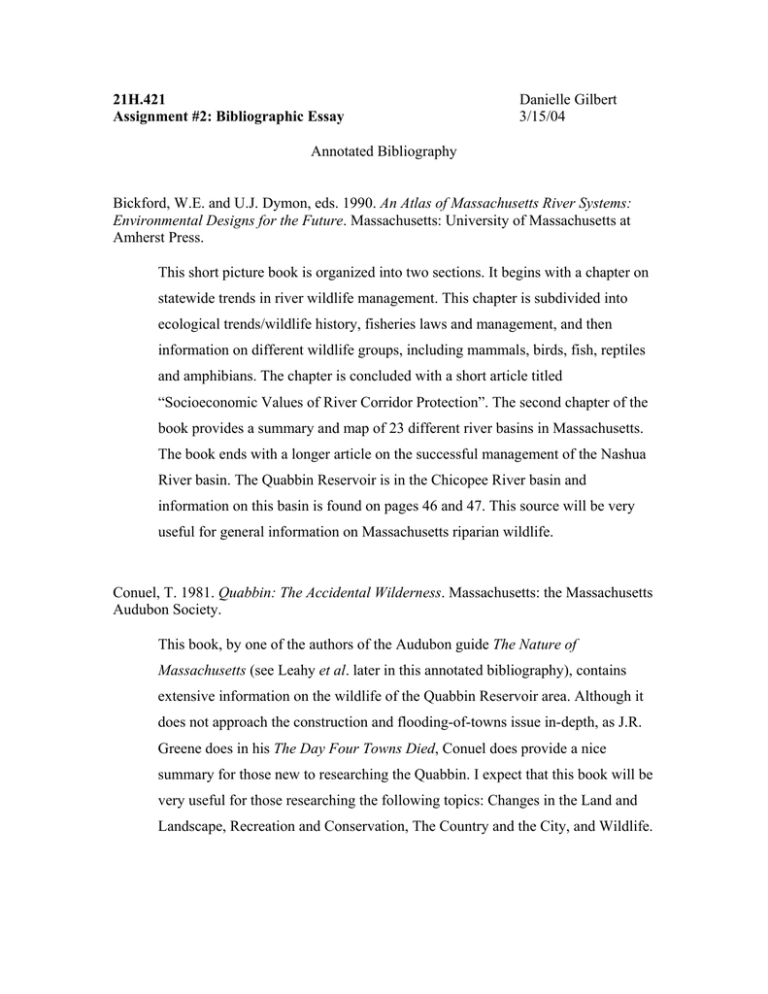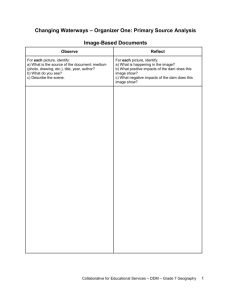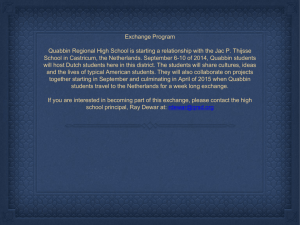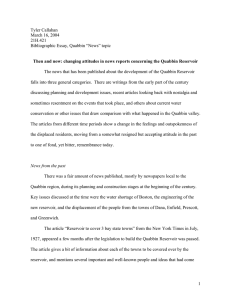21H.421 Assignment #2: Bibliographic Essay Danielle
advertisement

21H.421 Assignment #2: Bibliographic Essay Danielle Gilbert 3/15/04 Annotated Bibliography Bickford, W.E. and U.J. Dymon, eds. 1990. An Atlas of Massachusetts River Systems: Environmental Designs for the Future. Massachusetts: University of Massachusetts at Amherst Press. This short picture book is organized into two sections. It begins with a chapter on statewide trends in river wildlife management. This chapter is subdivided into ecological trends/wildlife history, fisheries laws and management, and then information on different wildlife groups, including mammals, birds, fish, reptiles and amphibians. The chapter is concluded with a short article titled “Socioeconomic Values of River Corridor Protection”. The second chapter of the book provides a summary and map of 23 different river basins in Massachusetts. The book ends with a longer article on the successful management of the Nashua River basin. The Quabbin Reservoir is in the Chicopee River basin and information on this basin is found on pages 46 and 47. This source will be very useful for general information on Massachusetts riparian wildlife. Conuel, T. 1981. Quabbin: The Accidental Wilderness. Massachusetts: the Massachusetts Audubon Society. This book, by one of the authors of the Audubon guide The Nature of Massachusetts (see Leahy et al. later in this annotated bibliography), contains extensive information on the wildlife of the Quabbin Reservoir area. Although it does not approach the construction and flooding-of-towns issue in-depth, as J.R. Greene does in his The Day Four Towns Died, Conuel does provide a nice summary for those new to researching the Quabbin. I expect that this book will be very useful for those researching the following topics: Changes in the Land and Landscape, Recreation and Conservation, The Country and the City, and Wildlife. Dizard, J.E. 1999. Going Wild: Hunting, Animal Rights, and the Contested Meaning of Wilderness. Massachusetts: University of Massachusetts at Amherst Press. From the title, I assumed this book would be a general review of wilderness management. Instead, I found that Dizard concentrated on the Quabbin, especially in the management of its deer populations. I skimmed the book and found these pages that contain information on Quabbin wildlife: 8, 12-14, 35-37, 69-71, 9598, 175-177, 210-211. A list of species is found on page 8, and Dizard introduces the deer problem on page 12. She reports the establishment of bald eagles in the Quabbin on pages 13 and 14, and then continues addressing the deer on pp. 35-37. Deer management is discussed on pp. 69-71 and hunting on pp. 95-98. Dizard gives the results of the first deer hunts on pp. 175-177 and, finally, provides a nice summary of Quabbin wildlife on pp. 210-211. Gorman, J., “Bald Eagles Resettling Their Old Neighborhood”. The New York Times. January 18, 2002. E.2:50. The reporter, James Gorman, goes on a bird-watching tour near Quabbin Reservoir to observe the famous bald eagles. In the article, he describes the introduction of eagles to the lake and their current status. As I am planning to use the eagles of Quabbin Reservoir as my topic for the final paper, I expect this source to be very useful. Unfortunately, Gorman does not see any bald eagles on his trip, but the article still covers the subject well. Greene, J.R. 1981. The Creation of the Quabbin Reservoir: the death of the Swift River Valley. Massachusetts: Performance Press. This source chiefly concerns the impact of the creation of the Quabbin on local residents. It covers the destruction of four towns: Prescott, Greenwich, Dana, and Enfield. Greene is the author of The Day Four Towns Died, another book on the Quabbin. It is likely that much of the information in The Creation of the Quabbin Reservoir is the same as that in The Day Four Towns Died. As for relevance to my topic, wildlife, all pertinent information is on one page, pg. 90. A summary of Greene’s points: o Quabbin Reservoir watershed was originally over-planted with pines, but current management seeks a more balanced forest. This is beneficial for wildlife. o Fish stocking has been very successful. (I wonder - what about native species?) o It was not economical to graze sheep. o Wild turkey stockings have been partially successful. o Deer, wildcats, eagles, and geese are found in the region. Leahy, C. et al. 1996. The Nature of Massachusetts. Massachusetts: Addison-Wesley Publishing Co., Inc. This book was published in celebration of the 100th anniversary of the Massachusetts Audubon Society. As is typical of Audubon-type publications, the information is very detailed and accompanied by exquisite illustrations (done by Lars Jonsson). Thomas Conuel, the author of Quabbin: The Accidental Wilderness is the third author of The Nature of Massachusetts. I was immediately struck by the beautiful cover page, which depicts a watercolor of a bald eagle flying over Quabbin Reservoir. The book is organized into four sections: The Sea and Shore, The Central Peneplain, The Connecticut River Valley, and The Western Highlands. I found information helpful regarding Quabbin wildlife in the Oak-Conifer Forest and Lakes and Ponds chapters in the Central Peneplain section. The Quabbin itself is mentioned just briefly, on page 134, as a good place to visit, with accompanying directions. Quabbin: The Accidental Wilderness is listed in the Further Reading section at the end of the Lakes and Ponds chapter. McCann, J.A. et al. 1972. Inventory of the Ponds, Lakes, and Reservoirs of Massachusetts – Worchester County. Massachusetts: Community Resource Development Program, University of Massachusetts at Amherst Press. This book is a result of a research project of the Water Resources Research Center at UMass Amherst. It contains maps and information on the physical characteristics on the major ponds and lakes in Worchester County, Massachusetts. Seven towns encompass Quabbin Reservoir: New Salem, Shutesbury, Pelham, Belchertower, Ware, Hardwick, and Petersham. Worchester County includes Hardwick and Petersham. A full-page map of Quabbin Reservoir, complete with town lines and water depths, is on pg. 170. Michniewicz, J. “Species counts below average”. Worchester Telegram & Gazette. February 25, 2003. D5 This article is a general summary of the fish and bird species that are found in the Quabbin Reservoir area. The inventory was performed by the U.S. Fish and Wildlife Service in January 2003. (I did not find a similar inventory for this year.) I intend to use this article, along with some of the other sources listed here, to create a list of the wildlife species found in the Quabbin region. Michniewicz does conclude that species counts are below average, but this estimate includes coastal species that do not inhabit the Quabbin reservoir area. Vaznis, B. “Quabbin’s whitetails”. The American Hunter 26, 9 (Sept. 1998): 20-21. This article is from a hunting magazine, The American Hunter. It begins with a short anecdote by the author about his “most memorable encounter with Quabbin Reservoir”. Vaznis then presents a summary of Quabbin Reservoir history, followed by an intelligent argument about deer control in the Quabbin area (the author does, however, use the phrase ‘whopper buck’). The article includes a map of the area and would be interesting and useful to any student researching the topic of deer management in the Quabbin Reservoir region. (National Wildlife Federation). “ ‘New forestry’ aids wildlife, economy in Massachusetts”. International Wildlife 28, 6 (Nov/Dec. 1998): 9. This article was submitted by the National Wildlife Federation to the journal International Wildlife. It discusses how forest management has enhanced the wildlife and natural beauty of the Quabbin Reservoir area, which in turn contributes to the state’s tourism industry and improves local property values. Unlike Going Wild by Dizard (see Dizard citation and accompanying notes), this article takes a positive stance on wildlife management, while Dizard presents both sides and generally remains neutral. This article includes the following quote from Mark Lorezno, a project manager for NWF, “You only have to walk through this forest to see that wildlife and economic activity coexist in harmony… If companies and government learn from this example, we can start restoring the balance of nature in forests all over America”. MIT OpenCourseWare http://ocw.mit.edu 21H.421 Introduction to Environmental History Spring 2011 For information about citing these materials or our Terms of Use, visit: http://ocw.mit.edu/terms.






